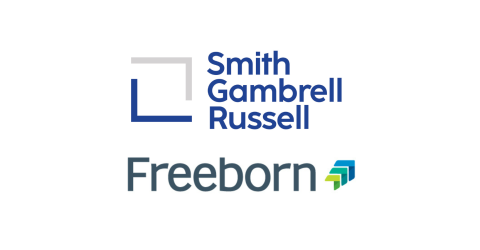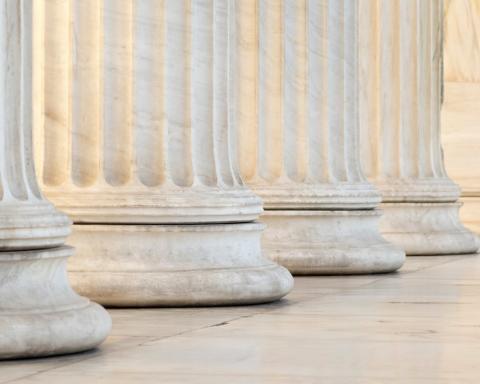Written by David S. Becker, Partner, Kimberly A. Beis, Partner, and Troy D. Smith, Partner for the Winter 2021 Edition of Powerhouse Points, A Quarterly Litigation Update. Read the full issue here.
Powerhouse Points:
- IP assets can be categorized into four different types.
- Patents protect an implementation of an idea.
- Copyrights protect the expression of an idea.
- Trademarks protect consumers by identifying the source of a product or service.
- Trade secrets protect valuable information that is not generally known to others.
When you look around a business, it’s easy to see the hard assets: products and equipment that could be lost, damaged, or stolen. Your clients would be foolish not to protect them, and there are some obvious ways to do it. For example, they can lock things away or, for smaller things, require employees to wear uniforms without pockets to reduce theft.
While hard assets are important, companies routinely are under-protected in an equally critical area. These are their soft assets, such as intellectual property (IP) and know-how. IP and key employees account for a large percent of many businesses’ value. In fact, they represent nearly all of the value in a number of technology-centered companies. Failing to understand and protect the ideas and processes your clients’ businesses create, and the customers they serve, could jeopardize their organizations’ futures.
As many of us are general practitioners, it is sometimes useful to have a handful of high-level tools to use to get our clients on the right path to protecting their IP. This article walks you through the four types of IP: patents, trademarks, copyrights, and trade secrets. It also shares steps your clients can take—some legal and many common sense—to reduce their vulnerability and prevent their companies from becoming cautionary tales.
Protecting Your Company’s Inventions and Ideas
Let’s start with patents. A patent is a government license for a product or process that allows a company or person to prevent others from using or selling the patented article for a certain amount of time.[i] In exchange for this license, the owner must publicly disclose the product or process.[ii] Here are 10 steps you can take to start protecting your inventions or ideas.
1. Make it clear you own the invention or process. Your employees need to know that while they are working for your company, anything they invent is company property.[iii] This should be spelled out in their employment agreement.[iv] The best-case scenario is to have employees sign an agreement when they join your business. However, if you didn’t have an appropriate process in place when employees came on board, you can still prepare one and have them sign it later.
The language you choose is very important. You need to ensure that your company has a right to own any inventions assigned to it. To make that clear, employees’ agreements should “assign all rights” to inventions to the company.[v] This is not to be confused with having “an obligation to assign all rights.” In the latter case, if the employee who created the invention moves to another company—and hasn’t yet assigned the rights—then he or she may be legally able to bring that information to the next employer.[vi] You can easily avoid this risk just by using the correct language.
2. Have employees keep a “notebook.” All of your employees who are involved in developing patentable products or processes should have a place where they record and date their ideas. This is particularly true of engineers and technical people.
A traditional approach is to have a notebook where these items are recorded. Then someone else at the company can review the notebook, agree that this was the person’s idea, and attest to the date of invention.[vii] The goal is to have a written record witnessed by a non-inventor employee to protect the company in case of litigation.
This remains a valid process. With the proliferation of electronic devices, however, more tech-savvy employees are lured to the use of smartphones, tablets, etc. As this happens, companies need to be aware of and take action to avoid entries being modified later, or employees walking out the door with these ideas. You should ensure there are safeguards to the system and, appropriately, treat these ideas as trade secrets (which are discussed more fully later).[viii]
3. Regularly analyze ideas. You need a process to review the new ideas and concepts your employees create. If not, your company will just have a pile of ideas with dates that never amount to anything actionable. This process not only allows others to see the great ideas employees have developed, but it also makes it easy for them to discuss whether there is an opportunity to obtain a patent. This activity may be formal or informal, but it must be part of your business routine.[ix] There is more than a legal concern here. From a business perspective, you need to validate whether or not it’s worthwhile to expend the resources to go through the patent process for a particular invention.[x] It’s also not a bad idea to keep apprised of your employees’ progress.
4. Evaluate competitors’ patents. One goal of looking at competitors’ patents is to make sure you’re not infringing on these and exposing the company to costly litigation. This allows you to determine if you need to secure a license for a product or activity before you face a lawsuit.[xi]
Patent review also has additional business benefits. You get to see the ideas that have inspired your peers to take action. Knowing this may spark your people’s imagination, too, and take you in a new direction. It can also reveal ideas in expired patents that you can use. In addition, you learn areas that are not currently covered by patents, which can then be used in your own patent strategy.[xii]
Expired patents may also be reviewed for business advantages. Depending upon when the other company’s now-expired patent was issued, technology may have changed and made a product, process, or service possible—or cost-effective—when it wasn’t before. This gives you an opportunity to leverage another company’s work for your benefit.
5. Determine if an idea is worth patenting. Determining if a patent application should be filed may sound simplistic, but before you initiate a patent application, consider if what you are patenting (1) actually is patentable and (2) has enough market value, before getting too far down the line.[xiii] On the first point, a good place to start is to search for similar types of patents. You don’t need a lawyer for this (but you can use one and/or obtain an advisory opinion from your lawyer regarding patentability). Both Google and the U.S. Patent and Trademark Office (USPTO) have excellent databases you can access.[xiv] For the second point, it’s important to remember that what might be interesting to you may not have enough value in the marketplace to warrant this expenditure.
However, there is another consideration: litigation. It’s generally less expensive to go through the patent process than it is to go to court—although getting a patent can be a pricey prospect. Obtaining a patent for your invention can allow you to enforce a patent you believe others infringe, or to reduce the risk of others taking you to court for infringing upon their IP.
6. Decide if your idea serves you better as a patent or a trade secret. There are times when it makes sense to keep something a trade secret rather than patent it.[xv] We’ll discuss trade secrets in the next section. For now, it’s useful to know that important types of trade secrets include designs or processes with real value, which only your company can do, and which can’t be easily reverse-engineered by someone else. This is not to be confused with a product you sell, which someone can take apart to understand how it works.
7. Know who owns what when circumstances change. When involved with third parties, you need to agree on who will own all of the patents and any other IP that springs from the relationship—particularly when it’s over. Some arrangements will have a natural ending date. Others will be open-ended. Still others may not have an amicable end. Your initial contract should cover all of these possibilities.[xvi]
8. Keep it secret until it’s time to patent. Until you’re ready to file the application, be careful with whom you discuss patentable inventions. It also helps to have a policy on this that you share with employees. There are plenty of sad stories of companies that shared information when they shouldn’t have and saw their patentable opportunities snatched away by opportunists. There are also situations where a company’s early sales efforts only served to later invalidate its patent.[xvii]
9. Know when to use provisional patents. Provisional patent applications allow you to stake out your invention up to a year before actually filing a patent application. The catch is that you need to be thorough in the disclosure of your idea (which will not be made public while you decide whether you want to proceed with the application), because the ultimate patent will only cover what’s disclosed in the provisional patent.[xviii]
10. Consider the geographic areas related to your patent. Think about where in the world you do business and where your competitors are located. Then determine the territories where your patent needs to be protected. You don’t want to spend the money to get a patent in Europe if you’re only marketing a product in the U.S.—when only filing there should be adequate.[xix]
In addition, be aware that patents are only protected in the territories where they are issued. This means other countries, such as China, do not enforce U.S. patents. If you send a product for manufacturing or sell your product in China but don’t have a Chinese patent, you don’t have the same options for keeping competitors from using your invention.
Protecting Your Trade Secrets
A trade secret can be information—including a formula, pattern, compilation, or program—or a device, method, technique, or process. It must have two qualities: (1) it has actual or potential economic value because it isn’t generally known and is not easily understood or replicated by others; and (2) the company that uses it must make reasonable efforts to maintain its secrecy.[xx]
To successfully sue another party for misappropriating a trade secret requires that you prove two points. The first is where the people got access to the information. The second is that they should have known the information was confidential, and they acquired it without the company’s permission.[xxi]
Here are 10 ways you can start strengthening the protection of your company’s trade secrets:
1. Store information on your trade secrets in a physically secure place. Whether these are paper or computer files, they should not be easily accessed by unauthorized individuals.
2. Clearly identify and label trade secrets. Here are three examples of the wording you could use:
• This information is proprietary to ABC Company and shall not be duplicated, used, or disclosed. It also can’t be reproduced without written permission.
• Confidential and proprietary information of ABC Company. Do not disclose outside the company.
• ABC Company Confidential—Do Not Copy
3. Have all employees read and sign confidentiality or nondisclosure agreements.
4. Limit the distribution of materials containing trade secret information—and don’t let employees leave physical copies lying around.
5. Have a document destruction program.
6. Limit access to trade secret materials. This includes placing things like machines and prototypes in walled-off or fenced-in places. Also require employees to sign out physical materials or documents. Maintain passcodes and logins to computers or areas of the network that house this information.
7. Hold regular meetings to remind employees of their obligation to protect trade secrets. You can even use meetings on other topics as opportunities for reminders on this.
8. Lock out computer features that permit employees to save information to external drives. Also, prevent access to online services such as Google Drive, Dropbox, etc. In addition, have a policy about the use of instant messaging and/or chat programs and sharing information on trade secrets. Comments there can be “scraped” by third parties looking for confidential data.
9. Conduct exit interviews and collect devices on which employees may have stored confidential information. These include smartphones, laptops, hard drives, thumb drives, etc.
10. Be careful when choosing and dealing with outside contractors and vendors who will need access to trade secret materials. Make sure to address the protection of all of your IP up front in any contract.
Protecting Your Trademarks
Recognizable signs, designs, or expressions can be trademarked. Trademarking is used to identify a product or service as coming from a specific source.[xxii] Putting a trademark on something shows that you have taken the extra step to protect your claim to it. The following five actions can help to ensure your trademarks are in order.
1. Make it fanciful. Try to make your mark unusual. For example, “Apple” has nothing to do with either computers or making records, but it is memorable, so it has supported strong brands for the computer maker and the Beatles. On the other hand, some trademarks are closely aligned with or suggest what the item is. These can be harder to legally protect.[xxiii]
“Bacon Salt” is a great example: a name that exactly described its product. Because this was a relatively generic term, it would have been difficult to obtain a trademark on it. To ensure that the company’s unique new product could be marketed and identified in a protectable manner, the owners took action to strengthen their brand identity beyond just that product. First, they used the two founders’ initials to show it was their product. Second, they created an original piece of art (in the shape of a pig) that was paired with the initials and the product name. Because these two strategies differentiate J&D’s Bacon Salt, the trademark was stronger—and the product is distinguished in the marketplace. It also doesn’t hurt that J&D’s Foods went out and secured the internet address baconsalt.com.
2. Use TM or SM right away. Start incorporating these marks into your art immediately. This is free and something that doesn’t require you to work with an attorney first.[xxiv] When you’re ready, you may file your application for a registered trademark online with the USPTO. The process is likely to take some time.
Once you apply the TM or SM, you indicate to the world that your brand is a trademark associated with your business. Protection, however, will only extend to the field (i.e., industry) and geography of your use. This means if you only operate in a single state or locality, the protection may not extend beyond that place without registering the mark.
Local protection is still useful. There are instances in which local businesses are permitted to use a mark that was later adopted by a large national or international entity. This is the case for Burger King in Mattoon, Illinois. Here, a privately operated store called Burger King does business independently of the large national chain, based on earlier actual use of the name there. But the exclusive right to the name for the Mattoon restaurant only extends for a 20-mile radius around that town.
3. Conduct a search before using or filing for a new mark. You want to make certain no one else is already using the mark (or something very similar). While this seems like a no-brainer, you would be surprised at the number of companies that don’t bother to check and wind up paying filing fees to the USPTO only to later discover the desired mark is already taken.[xxv] It’s simple and doesn’t cost much. Start with a Google search and then move on to search the databases publicly available at the USPTO’s website.[xxvi]
4. Monitor your trademarks. As your portfolio of trademarks expands, it is important to adopt a system or process to ensure your registrations are maintained and renewed.[xxvii] Lawyers often can be helpful in setting up these systems for you and/or maintaining your portfolio. After going through the time, effort, and expense of obtaining a trademark, the last thing you want to do is let it lapse. This risks someone else coming in and taking away your identity—or additional costs to reinstate the trademark.
5. Make sure others use your mark correctly. This means more than ensuring third parties are licensed to use your mark and presenting it in the right colors, sizes, and typefaces. You also want to know that they are maintaining a high level of quality that supports your brand value and leaves a strong positive impression in the market.[xxviii]
Protecting Your Copyrights
Copyrighting an original work gives the creator exclusive rights during the creator’s lifetime, plus 70 years.[xxix] It’s important for your employees and those in work-for-hire (independent contractor) situations to know that their copyrightable work will be owned by the company.[xxx] Here are five key ways to help control your copyrighted material.
1. Mark the materials that you and your employees create with a © and the date. Since 1978, copyright protection in the U.S. and many other jurisdictions has been automatic—regardless of how the work is marked.[xxxi] The best practice is to use a © and the year it was created.[xxxii] If you want to pursue infringement claims in federal court, however, you will need to register your copyright first. Pursuing claims in federal court allows you to seek statutory damages and attorney fees. Statutory damages mean you receive remuneration for every copy that was illegally used or sold.
2. Have agreements in place. Make it clear that copyrighted materials are being created on a work-for-hire basis and are owned by the company. Have employees and independent contractors sign this agreement.
3. Get full value for copyrighted materials. This is particularly important when resale of the work is contemplated. In the case of Kirtsaeng v. John Wiley & Sons, a young man from Thailand came to the U.S. to study mathematics.[xxxiii] While here, he learned that English-language editions of his textbooks could be purchased in Thailand for much less than the same versions in the U.S. He asked friends and family in Thailand to purchase copies and send them to him. He then sold the books in the U.S. and kept the profits.
The publisher sued for copyright infringement. Despite winning the case in the trial court and the U.S. Court of Appeals for the Second Circuit, the ruling was overturned by the U.S. Supreme Court. The justices explained that regardless of where a work is manufactured, if it is made with the permission of the owner, U.S. copyright law entitles the purchaser to sell that work to another.
So companies—particularly when they operate globally—should make sure they get the full value of any sale of a copyrighted work. That is likely the only bite at the apple they will get.
4. Know what rights you’re giving to another. Copyrights—like other IP rights—are made up of a number of different rights, such as the right of use and the right to disseminate. Understand what these are and what you are allowing another party to do when you assign a copyright or part of a copyright to it.
5. Pay close attention when software is involved. You will want to secure the source code—by registering it secretly with the Library of Congress—and obtain copyrights. This is important, once again, because infringement allows you to collect damages for every copy sold.
Protect All of Your Assets
Now that you know the areas where you can guide your clients most easily, the next thing to do is to get them to act. At a minimum, encourage your clients to start (if they have not already) (1) regularly analyzing patentable ideas, (2) keeping trade secrets in a secure place, (3) using appropriate marks for branding and logos, and (4) marking materials with a © and the date.
That said, it can be hard to know how well your client’s current practices are protecting their organizations and where they are at risk. In addition, many facets of IP protection are more opaque and complex. For both of these situations, it makes sense to work with specialized IP counsel. Doing that can actually save you and your clients time, money, and frustration, and reduce the chances people will infringe on your clients’ IP—or at least everyone can work together to ensure those who do infringe pay the price for it.
[i]. Innova/Pure Water, Inc. v. Safari Water Filtration Sys., 381 F.3d 1111, 1115 (Fed. Cir. 2004) (“It is a bedrock principle of patent law that the claims of a patent define the invention to which the patentee is entitled the right to exclude.”).
[ii]. Enzo Biochem, Inc. v. Gen-Probe Inc., 323 F.3d 956, 970 (Fed. Cir. 2002) (“[T]he public must receive meaningful disclosure in exchange for being excluded from practicing the invention for a limited period of time.”).
[iii]. Edward L. Raymond Jr., Annotation, Construction and Effect of Provision of Employment Contract Giving Employer Right to Inventions Made by Employee, 66 A.L.R.4th 1135, at § 2(a) (1994).
[iv]. 8 Donald S. Chisum, Chisum on Patents § 22.03 (2020).
[v]. DDB Techs., L.L.C. v. MLB Advanced Media, L.P., 517 F.3d 1284, 1290 (Fed. Cir. 2008) (“Applying federal law, we have held that whether an assignment of patent rights in an agreement such as the one in this case is automatic, requiring no further act on the part of the assignee, or merely a promise to assign depends on the contractual language.”).
[vi]. Arachnid, Inc. v. Merit Indus., Inc., 939 F.2d 1574, 1580 (Fed. Cir. 1991) (“[The] consulting agreement was an agreement to assign, not an assignment. Its provision that all rights to inventions developed during the consulting period ‘will be assigned’ . . . does not rise to the level of a present assignment of an existing invention, effective to transfer all legal and equitable rights therein . . . .”).
[vii]. Medichem, S.A. v. Rolabo, S.L., 437 F.3d 1157, 1170 (Fed. Cir. 2006) (“[A]n unwitnessed notebook is insufficient on its own to support a claim of reduction to practice.”).
[viii]. Lisa A. Dolak, Patents without Paper: Proving a Date of Invention with Electronic Evidence, 36 Hous. L. Rev. 471 (1999).
[ix]. See generally Louis M. Brown et al., The Legal Audit: Corporate Internal Investigation § 8:107 (2020) (protection of new interests).
[x]. William Elias II & Kirk Teska, Managing the High Costs of Patents: Tips for Getting the Most from Your Patent Committee, 23 ACC Docket 31 (May 2005).
[xi]. Eric Bensen, U.S. Patent Opinions and Evaluations § 7.02 (2020).
[xii]. Id.
[xiii]. Lawrence A. Stahl & Robert H. Fischer, Establishing an Intellectual Property Program, 23 No. 3 Intell. Prop. & Tech. L.J. 19 (March 2011).
[xiv]. See Google Pats. Search, https://www.google.com/?tbm=pts (last visited Jan. 12, 2021); Search for Patents, U.S. Pat. & Trademark Off., https://www.uspto.gov/patents/process/search/index.jsp (last modified Aug. 31, 2020).
[xv]. Andrew Beckerman-Rodau, The Choice Between Patent Protection and Trade Secret Protection: A Legal and Business Decision, 84 J. Pat. & Trademark Off. Soc’y 371, 371–72 (2002).
[xvi]. 1 Clarence H. Ridley et al., Computer Software Agreements: Forms and Commentary § 6:1 (2020) (decision-making chart for ownership rights in a research and development collaboration).
[xvii]. Mauri Aven & Nicole Bashor, 7 Ways to Minimize the Risk of Losing Patent Rights Through Disclosure, 37 ACC Docket 38, 39 (Sept. 2019).
[xviii]. 4 John Gladstone Mills et al., Patent Law Fundamentals § 15:5 (2d ed. 2020) (benefit of filing dates of earlier filed provisional applications).
[xix]. 5 Robert L. Haig, Successful Partnering Between Inside and Outside Counsel § 68:29 (2020) (foreign filing decisions).
[xx]. 1 Roger M. Milgrim & Eric E. Bensen, Milgrim on Trade Secrets § 1.01 (2020).
[xxi]. 4 id. § 16.01.
[xxii]. 1 J. Thomas McCarthy, McCarthy on Trademarks and Unfair Competition § 4:3 (5th ed. 2019) (“trademark” and “technical trademark”).
[xxiii]. Id. § 3:5 (informational words and slogans).
[xxiv]. 3 id. § 19:148 (use of “TM” or “trademark” with goods or services).
[xxv]. Id. § 19:6 (search of marks preparatory to application or selection).
[xxvi]. Search Trademark Database, U.S. Pat. & Trademark Off., https://www.uspto.gov/trademarks-application-process/search-trademark-database (last modified May 7, 2020).
[xxvii]. 3 McCarthy, supra note 22, § 19:142 (renewal of registrations).
[xxviii]. Id. § 18:48 (effect of naked licensing).
[xxix]. 7 Melville B. Nimmer & David Nimmer, Nimmer on Copyright § 302 (2019).
[xxx]. 1 id. § 5.03.
[xxxi]. 2 id. § 7.16.
[xxxii]. Id. § 7.08.
[xxxiii]. 568 U.S. 519 (2013).
©2021. Published in The Brief, Winter 2021, by the American Bar Association. Reproduced with permission. All rights reserved. This
information or any portion thereof may not be copied or disseminated in any form or by any means or stored in an electronic database
or retrieval system without the express written consent of the American Bar Association or the copyright holder.









